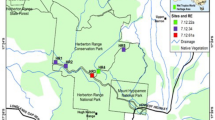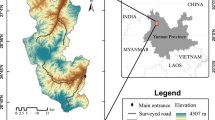Abstract
Road sides provide suitable conditions for the establishment and growth of non-native species. The phenomenon of non-native species spread through roads has further increased due to rapid anthropogenic developments. Here we intend to investigate the status of native and non-native species and how the species richness and diversity change in a perpendicular road transect across the three different road use types in the central highlands of India. Presence of 55 non-native species was recorded, of the total 71 species along the road sides. Non-native species richness significantly increased with increasing road use type. Although, the species diversity significantly decreased from road verges to the forest interior in all the road use types. Indicating the role of non-native propagule spread through the roads into the interior forest landscapes. The study gives a management implication, to restrict the non-native species spread from the road sides to the forest interior, irrespective of road use types.
Similar content being viewed by others
References
Amor, R. L., & Stevens, P. L. (1975). Spread of weeds from a roadside into sclerophyll forest at Dartmouth, Australia. Weed Research, 16, 111–118. doi:10.1111/j.1365-3180.1976.tb00388.x.
Anonymous (2003). District of India. Retrieved on line from URL: www.statoids.com/yin.html Accessed on 5 June 2005.
Anonymous (2007). National Highways Authority of India, National Highways Development Project Map, retrieved on line from URL: http://www.nhai.org/roadnetwork.htm Accessed on 11 Feb 2007.
Arévalo, J. R., Delgado, J. D., Otto, R., Naranjo, A., Salas, M., & Fernández-Palacios, J. M. (2005). Distribution of alien vs. native plant species in roadside communities along an altitudinal gradient in Tenerife and Gran Canaria (Canary Islands). Perspectives in Plant Ecology, Evolution and Systematics, 7, 185–202. doi:10.1016/j.ppees.2005.09.003.
Beier, P., & Noss, R. F. (1998). Do habitat corridors provide connectivity? Conservation Biology, 12(6), 1241–1252. doi:10.1046/j.1523-1739.1998.98036.x.
Cantero, J. J., Liira, J., Cisneros, J. M., Gonzalez, J., Nuñez, C., Petryna, L., et al. (2003). Species richness, alien species and plant traits in Central Argentine mountain grasslands. Journal of Vegetation Science, 1, 129–136. doi:10.1658/1100-9233(2003)014[0129:SRASAP]2.0.CO;2.
Christen, D., & Matlack, G. (2006). The role of roadsides in plant invasions: A demographic approach. Conservation Biology, 20, 385–391. doi:10.1111/j.1523-1739.2006.00315.x.
Connell, J. H. (1978). Diversity in tropical rain forest and coral reefs. Science, 199, 1302–1310. doi:10.1126/science.199.4335.1302.
Curtis, J. T. (1959). The vegetation of Winconsin: An ordination of plant communities. Madison: University of Winconsin Press.
Elton, C. (1958). The ecology of invasions by plants and animals. London: Methuen.
Flory, S. L., & Clay, K. (2006). Invasive shrub distribution varies with distance to roads and stand age in eastern deciduous forests in Indiana, USA. Plant Ecology, 184, 131–141. doi:10.1007/s11258-005-9057-4.
Gelbard, J. L., & Belnap, J. (2003). Roads as conduits for exotic plant invasions in a semiarid landscape. Conservation Biology, 17, 420–432. doi:10.1046/j.1523-1739.2003.01408.x.
Gelbard, J. L., & Harrison, S. (2003). Roadless habitats as refuges for native grasslands: Interactions with soil, aspect, and grazing. Ecological Applications, 13, 404–415. doi:10.1890/1051-0761(2003)013[0404:RHARFN]2.0.CO;2.
Gilliam, F. S. (2007). The ecological significance of the herbaceous layer in temperate forest ecosystems. Bioscience, 57, 845–858. doi:10.1641/B571007.
Gonzalez, A., Lawton, J. H., Gilbert, F., Blackburn, T. M., & Evans-Freke, I. (1998). Metapopulation dynamics, abundance, and distribution in a microecosystem. Science, 281, 2045–2047. doi:10.1126/science.281.5385.2045.
Hansen, M. J., & Clevenger, A. P. (2005). The influence of disturbance and habitat on the presence of non-native plant species along transport corridors. Biological Conservation, 125, 249–259. doi:10.1016/j.biocon.2005.03.024.
Harrison, S., Hohn, C., & Ratay, S. (2002). Distribution of exotic plants along roads in a peninsular nature reserve. Biological Invasions, 4(4), 425–430. doi:10.1023/A:1023646016326.
Hawbaker, T. J., & Radeloff, V. C. (2004). Roads and landscape pattern in northern Wisconsin: A comparison of four different road data sources. Conservation Biology, 18(5), 1233–1244. doi:10.1111/j.1523-1739.2004.00231.x.
Hawbaker, T. J., Radeloff, V. C., Hammer, R. B., & Clayton, M. K. (2004). Road density and landscape pattern in relation to housing density, land ownership, land cover, and soils. Landscape Ecology, 20, 609–625. doi:10.1007/s10980-004-5647-0.
Huston, M. A., & DeAngelis, D. L. (1994). Compettion and coexistence: The effects of resource transport and supply rates. American Naturalist, 144, 954–977. doi:10.1086/285720.
Jackson, B. D. (Ed.) (1895). Index kewensis. Oxford, UK: Clarendon Press.
Kadmon, R., & Benjamini, Y. (2006). Effects of productivity and disturbance on species richness: A neutral model. American Naturalist, 167, 939–946. doi:10.1086/504602.
Kowarik, I., & von der Lippe, M. (2007). Pathways in plant invasions. In W. Nentwig (Ed.), Biological invasions, ecological studies (Vol. 193, pp. 29–47). Berlin, Germany: Springer.
Lonsdale, W. M., & Lane, A. M. (1994). Tourist vehicles as vectors of weed seeds in Kakadu National Park, Northern Australia. Biological Conservation, 69, 277–283. doi:10.1016/0006-3207(94)90427-8.
May, R. M. (1973). Stability and complexity in model ecosystems. Princeton, NJ, USA: Princeton University Press.
Milton, S. J. (2004). Grasses as invasive alien plants in South Africa. South African Journal of Science, 100, 69–75.
Milton, S. J., & Dean, W. R. J. (1998). Alien plant assemblages near roads in arid and semi-arid South Africa. Diversity & Distributions, 4, 175–187. doi:10.1046/j.1472-4642.1998.00024.x.
Pauchard, A., & Alaback, P. B. (2004). Influence of elevation, land use, and landscape context on patterns of alien plant invasions along roadsides in protected areas of south-central Chile. Conservation Biology, 18, 238–248. doi:10.1111/j.1523-1739.2004.00300.x.
Pauchard, A., & Shea, K. (2006). Integrating the study of nonnative plant invasions across spatial scales. Biological Invasions, 8, 399–413. doi:10.1007/s10530-005-6419-8.
Pyšek, P., & Hulme, P. E. (2005). Spatio-temporal dynamics of plant invasions: Linking pattern to process. Ecoscience, 12, 302–315. doi:10.2980/i1195-6860-12-3-302.1.
Raizada, P., Sharma, G. P., & Raghubanshi, A. S. (2008). Ingress of lantana in dry tropical forest fragments: Edge and shade effects. Current Science, 94, 180–182.
Rentch, J. S., Fortney, R. H., Stephenson, S. L., Adams, H. S., Grafton, W. N., & Anderson, J. T. (2005). Vegetation–site relationships of roadside plant communities in West Virginia, USA. Journal of Applied Ecology, 42, 129–138. doi:10.1111/j.1365-2664.2004.00993.x.
Richardson, D. M., Pyšek, P., Rejmánek, M., Barbour, M. G., Panetta, F. D., & West, C. J. (2000). Naturalization and invasion of alien plants: concepts and definitions. Diversity & Distributions, 6, 93–107. doi:10.1046/j.1472-4642.2000.00083.x.
Robinson, G. R., & Quinn, J. F. (1988). Extinction, turnover and species diversity in an experimentally fragmented California grassland. Oecologia, 76, 71–82.
Shannon, C. E., & Weaver, W. (1949). The mathematical theory of communication. Urbana, Illinois: University of Illinois Press.
Sharma, G. P., & Raghubanshi, A. S. (2006). Tree population structure, regeneration and expected future composition at different levels of Lantana camara L. invasion in the Vindhyan tropical dry deciduous forest of India. Lyonia, 11, 25–37.
Sharma, G. P., & Raghubanshi, A. S. (2007). Effect of Lantana camara L. cover on local depletion of tree population in the Vindhyan tropical dry deciduous forest of India. Applied Ecology and Environmental Research, 5(1), 109–121.
Sharma, G. P., Raghubanshi, A. S., & Singh, J. S. (2005b). Lantana invasion: An overview. Weed Biology and Management, 5, 157–167. doi:10.1111/j.1445-6664.2005.00178.x.
Sharma, G. P., Singh, J. S., & Raghubanshi, A. S. (2005a). Plant invasions: Emerging trends and future implications. Current Science, 88, 726–734.
Singh, A. K., Raghubanshi, A. S., & Singh, J. S. (2002). Medical ethnobotany of the tribals of Sonaghati of Sonbhadra district, Uttar Pradesh, India. Journal of Ethnopharmacology, 81(1), 31–41. doi:10.1016/S0378-8741(02)00028-4.
Stohlgren, T. J., Binkley, D., Chong, G. W., Kalkhan, M. A., Schell, L. D., Bull, K. A., et al. (1999). Exotic plant species invade hotspots of native plant diversity. Ecological Monographs, 69, 25–46.
Timmins, S. M., & Williams, P. A. (1991). Weed numbers in New Zealand’s forest and scrub reserves. New Zealand Journal of Ecology, 15, 153–162.
Trombulak, S. C., & Frissell, C. A. (2000). Review of ecological effects of roads on terrestrial and aquatic communities. Conservation Biology, 14, 18–30. doi:10.1046/j.1523-1739.2000.99084.x.
von der Lippe, M., & Kowarik, I. (2007). Long-distance dispersal of plants by vehicles as a driver of plant invasions. Conservation Biology, 21, 986–996. doi:10.1111/j.1523-1739.2007.00722.x.
von der Lippe & Kowarik, I. (2008). Do cities export biodiversity? Traffic as dispersal vector across urban–rural gradients. Diversity & Distributions, 14, 18–25.
Von Holle, B., & Simberloff, D. (2005). Ecological resistance to biological invasion overwhelmed by propagule pressure. Ecology, 86, 3212–3218. doi:10.1890/05-0427.
Wenny, D. G. (2001). Advantages of seed dispersal: A re-evaluation of directed dispersal. Evolutionary Ecology Research, 3, 51–74.
Author information
Authors and Affiliations
Corresponding author
Rights and permissions
About this article
Cite this article
Sharma, G.P., Raghubanshi, A.S. Plant invasions along roads: a case study from central highlands, India. Environ Monit Assess 157, 191–198 (2009). https://doi.org/10.1007/s10661-008-0527-8
Received:
Accepted:
Published:
Issue Date:
DOI: https://doi.org/10.1007/s10661-008-0527-8




